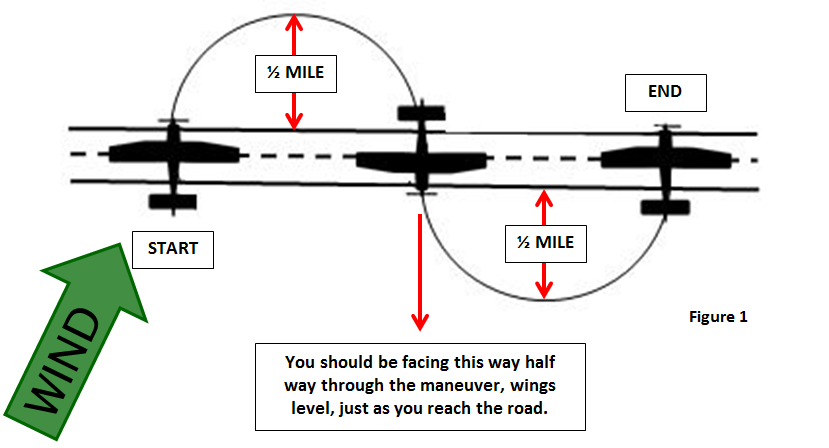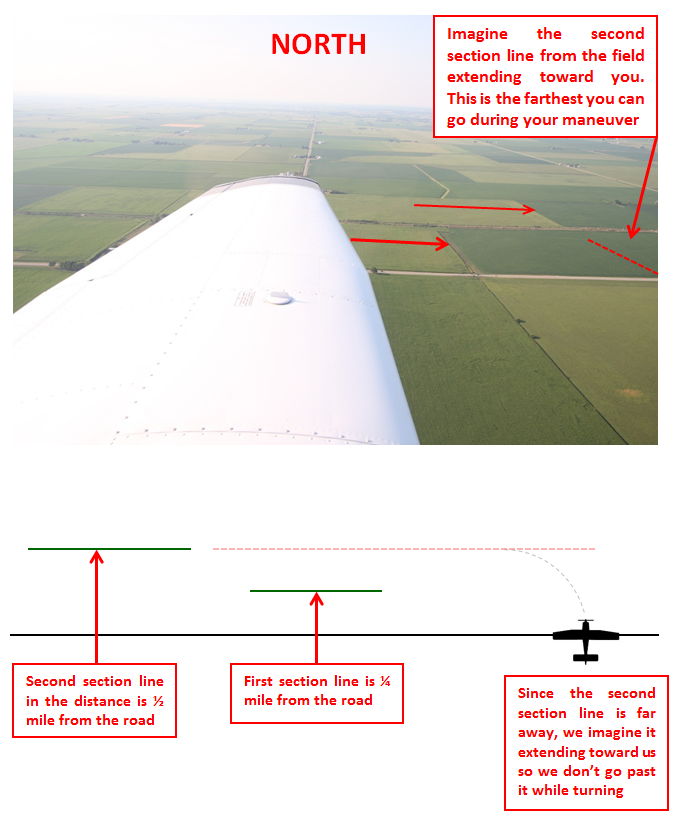This is what the S-Turn should look like. Notice how the wind is at the tail when you enter. Many people say it doesn’t matter because it doesn’t say it in the PTS. Entering with a tailwind is the proper way and it does say it in FAA publications. Why does it matter? There are a couple of reasons, one is that this maneuver is helping you with the skills you need for landing setup. When you come into the pattern you enter with a tailwind. The second is explained next.
You should enter with a tailwind and this is why; when you do your ground reference maneuvers, you want to plan them to not exceed 45° of bank. The distance from the road should be pretty tight, usually around 1/2 mile or less. Let’s assume that the winds were really strong and you entered the maneuver into the wind.
Turning required very little bank because the wind was pushing you back. By the time you get half way through the turn 1/2 mile from the road, you may only be in a 25° bank turn. As you turn toward the road for the second half of the maneuver, the wind is at your tail pushing you fast. You now begin the second half of the turn attempting to make it match the first half which was 1/2 mile from the road.
This is where the problem comes in. You’ve reached 45° of bank attempting to keep the same distance as the other side but the wind is pushing too hard. You have to exceed 45° of bank or increase the distance from the road. One will give you a bank that is too steep and the other will not give you equal semi circles and you will find out about it only when it’s too late.
If you entered with the tailwind first and attempted the 1/2 mile distance, you would see that holding 1/2 mile wouldn’t be possible with the current wind. You’d stop your bank at 45° and whatever the distance ended up being, you’d easily be able to do the same on the other side of the road because you’d then be going into the wind.
Another tip I have is for judging distance from the road. If you’re having a hard time maintaining equal distance on each side of the road while practicing S-Turns then use the section lines in the fields if you’re from an area that has them! They are nice and straight and easy to see and can help you judge your distance at a glance. Those who are from areas that don’t have them, sorry, you will have to use your best judgement.
Below is another picture from my ground reference maneuvers e-book that I’ve been sitting on for awhile. I haven’t made it available yet so if you guys like it enough I will make it available.Wings level, over the road at the start of the maneuver we are looking to the left for fields of equal size to judge our distance. Two of them will be about 1/2 mile. As long as you keep an eye on the section lines and make sure you don’t go past the one you choose or turn short of reaching it, then you will equal distances on both sides.
One last tip I have is to choose the highest altitude allowed to do your ground reference maneuvers. In the PTS it says to choose an altitude between 600′-1000′ agl. The latter is more common to what you’d see in a normal traffic pattern which will be more familiar to you and it will also give you more altitude in case of engine problems! I hope you enjoyed this!


